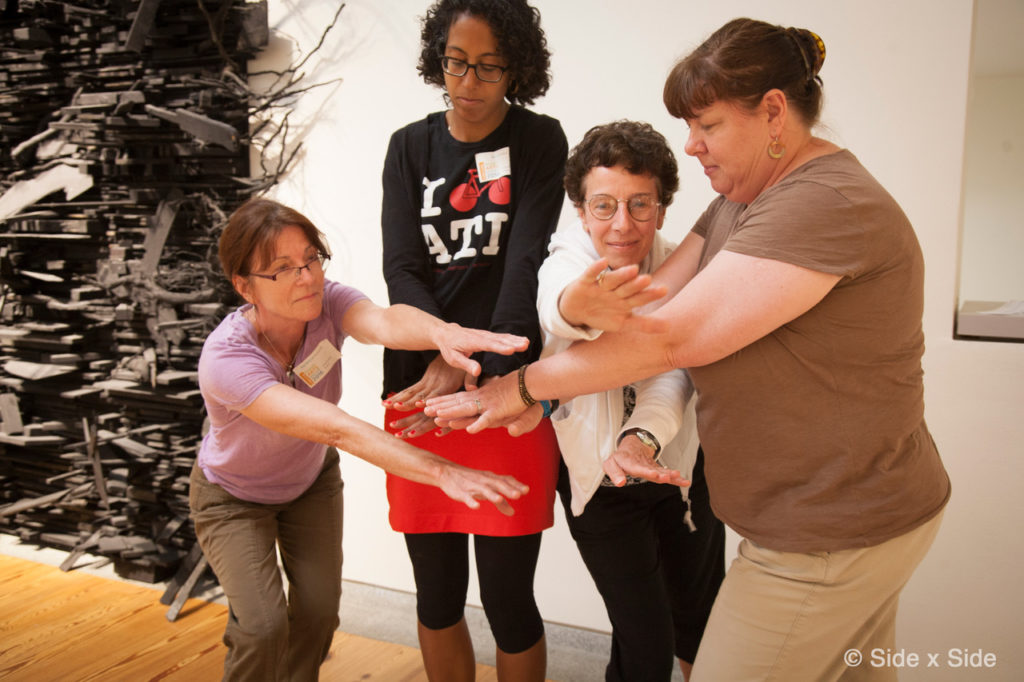Connecting Dots, Making Connections, Finding Partners

Photo courtesy of Side x Side
How do partnerships for professional development in arts integration take shape? In this posting we’ll look at the avenue down which one organization has traveled in forming partnerships over several years. Side-by-Side (SxS) in Portland, ME has made connections across the arts teaching workforce¹ that can appear to have taken place serendipitously but in reality were more about recognizing opportunities.
SxS began in 2011 as a small project when Beth Wilbur Van Mierlo, an artist-mom who ran an independent out-of-school arts program, recognized a need for more arts experiences in her children’s classrooms and recruited fellow artists to work with the students and teachers. When Kelly Hrenko, director of art education at the University of Southern Maine (USM), contacted Beth about finding internship placements for USM arts education students, Beth recognized the need for SxS to become an independent 501(c)3 organization. Kelly and Beth noticed that when artists and teachers worked side-by-side in the classroom, children responded enthusiastically, teachers grew in their knowledge of arts, and teaching artists grew in their knowledge of students’ needs. SxS has now grown to a staff of seven, employs several contractors and continues to collaborate with research partners and program evaluators.
SxS currently contracts with 15-20 teaching artists each year and partners with institutions around the region. The organization has received funding from several local and regional foundations as well as two consecutive grants from the U.S. Department of Education (ED). The recent grants provide ongoing professional development for teachers in 11 schools in partnership with two K-12 school districts, USM’s arts education program, Bates College, Portland Museum of Art and other not-for-profits and individuals in both Portland and Lewiston, ME.
How did the organization grow from a team of two to a cast of dozens? Part of the answer can be found in a list of recommendations for successful professional development of educators in arts integration noted by Diaz & McKenna (2017)². Since its inception, SxS has used these recommendations by fostering partnerships, engaging in collaborations with various stakeholders in arts integration, providing in-service professional development in schools, connecting with higher education and consistently seeking external funding to provide robust programming for students and teachers.
Collaborate with higher education. USM is a lead partner, with the chair of the art education program working closely with SxS to plan and implement its work with schools. Art education interns have the opportunity to work in SxS classrooms alongside teachers and teaching artists. The second ED grant expanded the work to Lewiston, where program leaders reached out to connect with artists and institutions in the community. A faculty member from Bates College with a background in art education serves as site consultant for the school near their campus and places interns in classrooms at the school.
Create partnerships within and across school districts. When SxS expanded to Lewiston, staff members reached out to local artists and institutions to identify resources in the community. Teachers from both districts continue to meet during the SxS Summer Arts Institute. Inter- and intra-district mentorship is fostered between experienced SxS teachers and colleagues.
Collaborate with teaching artists. SxS supports 15-20 local teaching artists recruited from both communities. Monthly teaching artist gatherings serve as a learning community, with artists exchanging ideas and practices. Attending artists learn together through targeted professional development in using technology for teaching, social-emotional learning, and diversity, equity and inclusion.
Connect with community experts. SxS encourages teachers and teaching artists to include relevant community experts – from graffiti artists to marine biologists – in the arts-integrated curriculum they design.
Connect with other local non-profits. SxS has built a network of collaborators, including two out-of-school education organizations with whom they have partnered on student programming and Community Cross Cultural Services, which facilitates professional development for staff, board members and contractors.
Each story of a new partnership through these connections emerges from some new need or unexpected opportunity. Keeping the vision alive means being open to opportunities to carry it forward by identifying partners.
² Diaz, G. & McKenna, M.B. (2017). Preparing Educators for Arts Integration. NYC: Teachers College Press.



